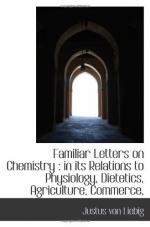At Hardwicke Court, near Gloucester, I have seen a garden (Mr. Baker’s) consisting of a stiff clay, which was perfectly sterile, become by mere burning extremely fertile. The operation was extended to a depth of three feet. This was an expensive process, certainly; but it was effectual.
The great difference in the properties of burnt and unburnt clay is illustrated by what is seen in brick houses, built in moist situations. In the town of Flanders, for instance, where most buildings are of brick, effloresences of salts cover the surfaces of the walls, like a white nap, within a few days after they are erected. If this saline incrustation is washed away by the rain, it soon re-appears; and this is even observed on walls which, like the gateway of Lisle, have been erected for centuries. These saline incrustations consist of carbonates and sulphates, with alkaline bases; and it is well known these act an important part in vegetation. The influence of lime in their production is manifested by their appearing first at the place where the mortar and brick come into contact.
It will now be obvious to you, that in a mixture of clay with lime, all the conditions exist for the solution of the silicated clay, and the solubility of the alkaline silicates. The lime gradually dissolving in water charged with carbonic acid, acts like milk of lime upon the clay. This explains also the favourable influence which marl (by which term all those varieties of clay rich in chalk are designated) exerts upon most kinds of soil. There are marly soils which surpass all others in fertility for all kinds of plants; but I believe marl in a burnt state must be far more effective, as well as other materials possessing a similar composition; as, for instance, those species of limestone which are adapted to the preparation of hydraulic cements,—for these carry to the soil not only the alkaline bases useful to plants, but also silica in a state capable of assimilation.
The ashes of coals and lignite are also excellent means of ameliorating the soil, and they are used in many places for this purpose. The most suitable may be readily known by their property of forming a gelatinous mass when treated with acids, or by becoming, when mixed with cream of lime, like hydraulic cement,—solid and hard as stone.




